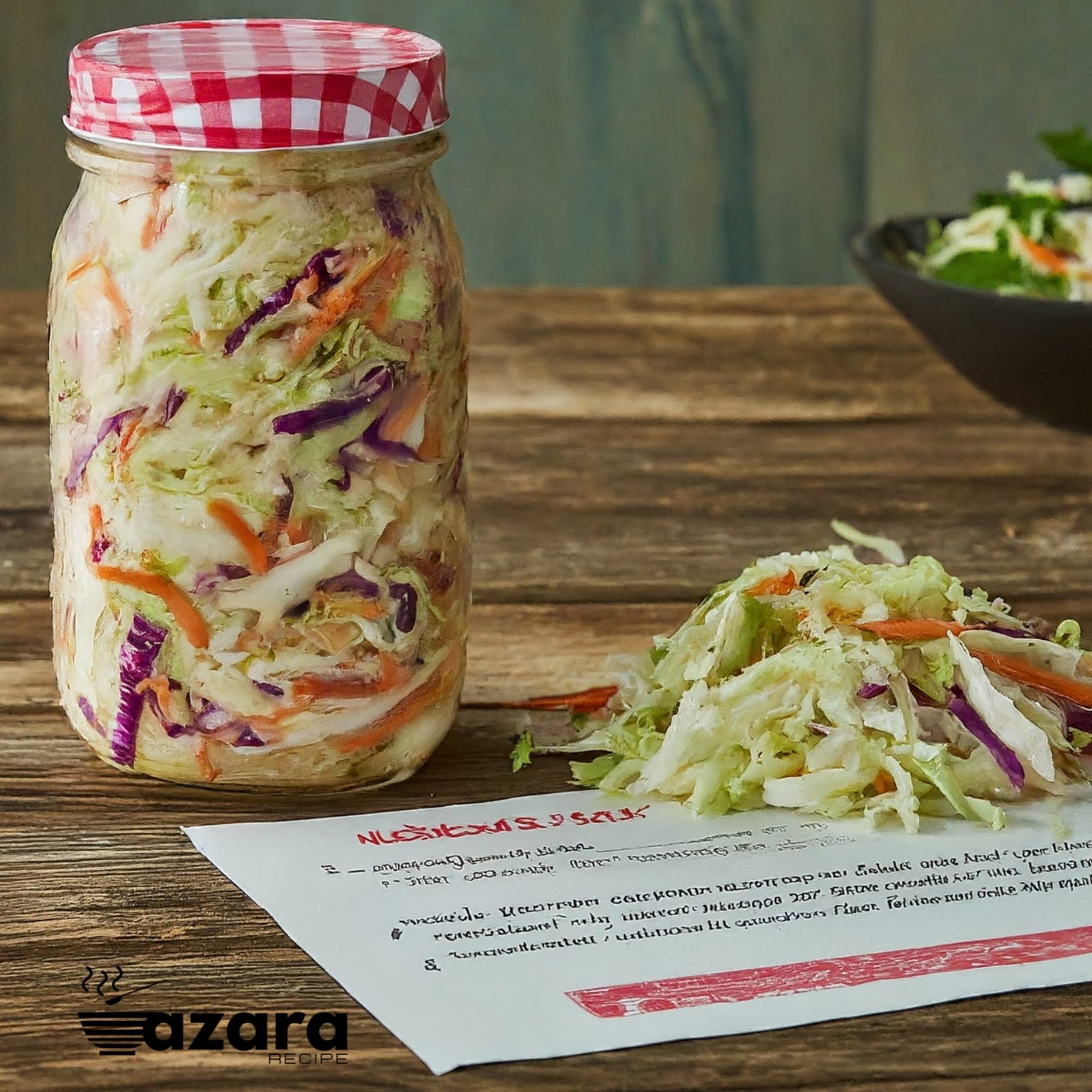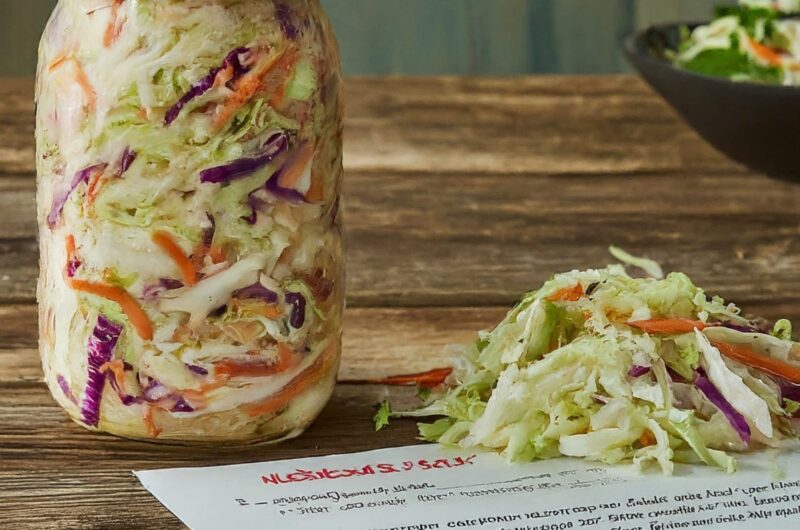Coleslaw is a beloved side dish that pairs wonderfully with a variety of meals. Its crisp texture and tangy flavor make it a refreshing accompaniment to barbecues, sandwiches, and more. Traditionally made with fresh cabbage and a tangy dressing, coleslaw can be time-consuming to prepare and doesn’t always keep well. Enter canned coleslaw – a convenient and delicious alternative that allows you to enjoy this classic dish anytime. This comprehensive guide will walk you through everything you need to know about making, storing, and serving canned coleslaw, ensuring that you always have a tasty side dish ready to go.
What is Canned Coleslaw?
Canned coleslaw is a method of preserving coleslaw so that it can be stored for extended periods and enjoyed whenever you like. Unlike traditional coleslaw, which must be eaten fresh, canned coleslaw is made with a brine that preserves the vegetables while maintaining their crunch and flavor. This method not only extends the shelf life of coleslaw but also enhances its tangy taste. Canned coleslaw is perfect for those who want to enjoy the convenience of having a ready-made side dish that can be quickly added to meals without the hassle of preparation.
How To Make Canned Coleslaw
Create culinary magic by gathering fresh ingredients, following step-by-step instructions, and adding your personal touch to make any recipe uniquely yours.
Ingredients of Canned Coleslaw
To make canned coleslaw, you will need the following ingredients:
| Ingredient | Quantity |
| Green cabbage | 1 large head |
| Carrots | 4 large |
| Red bell pepper | 1 large |
| White vinegar | 2 cups |
| Sugar | 1 cup |
| Water | 1 cup |
| Salt | 1 tablespoon |
| Mustard seeds | 1 tablespoon |
| Celery seeds | 1 tablespoon |
| Turmeric powder | 1 teaspoon |
Equipment for Canned Coleslaw
To prepare canned coleslaw, you will need the following equipment:
- Large mixing bowl
- Sharp knife or mandoline slicer
- Measuring cups and spoons
- Large pot
- Canning jars with lids
- Canning funnel
- Ladle
- Water bath canner
Instructions for Canned Coleslaw
- Prepare the Vegetables: Finely shred the cabbage, carrots, and red bell pepper using a sharp knife or mandoline slicer. Place them in a large mixing bowl.
- Make the Brine: In a large pot, combine the white vinegar, sugar, water, salt, mustard seeds, celery seeds, and turmeric powder. Bring the mixture to a boil, stirring until the sugar and salt are dissolved.
- Combine and Pack: Pour the hot brine over the shredded vegetables in the mixing bowl. Mix well to ensure all the vegetables are coated with the brine.
- Fill the Jars: Using a canning funnel, pack the coleslaw mixture into sterilized canning jars, leaving about 1/2 inch of headspace at the top. Ensure the vegetables are submerged in the brine.
- Seal the Jars: Wipe the rims of the jars with a clean, damp cloth to remove any residue. Place the lids on the jars and screw on the bands until fingertip-tight.
- Process the Jars: Place the jars in a water bath canner and ensure they are fully submerged in water. Bring the water to a boil and process the jars for 15 minutes.
- Cool and Store: Carefully remove the jars from the canner and let them cool on a towel or cooling rack. Check that the lids have sealed properly. Store the jars in a cool, dark place for up to a year.
What to Serve with Canned Coleslaw?
Canned coleslaw is a versatile side dish that pairs well with a variety of meals:
- Barbecue: Serve it alongside grilled meats like ribs, chicken, or pulled pork for a refreshing contrast.
- Sandwiches: Add it to sandwiches or burgers for extra crunch and flavor.
- Tacos: Use it as a topping for fish or chicken tacos.
- Picnic: Include it in your picnic basket as a convenient and tasty side dish.
- Fried Foods: Pair it with fried chicken or fish for a classic combination.

What Does the Recipe Taste Like?
Canned coleslaw has a tangy and slightly sweet flavor, thanks to the vinegar and sugar brine. The spices, including mustard seeds, celery seeds, and turmeric, add depth and complexity to the taste. The vegetables retain their crunch, providing a satisfying texture. The overall flavor profile is refreshing and vibrant, making it a great addition to various dishes.
How Healthy is this Recipe?
Canned coleslaw can be a healthy addition to your diet, depending on the ingredients used:
- Low in Fat: The recipe is low in fat since it doesn’t require mayonnaise or other fatty dressings.
- Rich in Vitamins: The cabbage, carrots, and red bell pepper provide vitamins A and C, fiber, and other essential nutrients.
- Controlled Sugar: While the recipe contains sugar, you can adjust the amount to suit your dietary preferences.
- Sodium Content: Be mindful of the salt content, especially if you are monitoring your sodium intake.
Pro Tips for the Perfect Canned Coleslaw
Here are some expert tips to ensure your canned coleslaw turns out perfectly every time:
- Sterilize Jars: Always sterilize your canning jars and lids to prevent contamination and ensure a safe seal.
- Uniform Shredding: Shred the vegetables uniformly for even texture and consistent flavor distribution.
- Adjust Brine: Taste the brine before adding it to the vegetables. Adjust the sugar and salt to suit your preference.
- Proper Headspace: Leave the correct headspace in the jars to ensure a proper seal and prevent spoilage.
- Check Seals: After processing, check that the jars have sealed properly by pressing the center of each lid. If it doesn’t pop back, the jar is sealed.
What Makes This Recipe Delicious?
The canned coleslaw recipe stands out for its balance of flavors and textures. The tangy, sweet brine enhances the natural flavors of the vegetables while the spices add depth and complexity. The crunchy texture of the cabbage, carrots, and red bell pepper remains intact, providing a satisfying contrast to the soft brine. The convenience of having a ready-made side dish that retains its freshness and flavor makes canned coleslaw a delicious and practical option for any meal.
Frequently Asked Questions
How long can I store canned coleslaw?
Canned coleslaw can be stored in a cool, dark place for up to a year.
Can I use red cabbage instead of green cabbage?
Yes, red cabbage can be used and will add a vibrant color to the coleslaw.
Do I need to refrigerate canned coleslaw?
Once opened, canned coleslaw should be refrigerated and consumed within a week.
Can I reduce the sugar in the recipe?
Yes, you can adjust the sugar to suit your taste preferences.
Is it necessary to use a water bath canner?
Yes, processing the jars in a water bath canner ensures the coleslaw is safely preserved and prevents spoilage.
Nutrition Facts of Canned Coleslaw
Here's a breakdown of the nutritional content per serving (1/2 cup):
| Nutrient | Amount |
| Calories | 50 |
| Carbohydrates | 12g |
| Sugars | 8g |
| Sodium | 200mg |
| Protein | 1g |
Recipe Variation
The canned coleslaw recipe can be adapted to suit different tastes and dietary preferences:
- Spicy Coleslaw: Add red pepper flakes or sliced jalapeños to the brine for a spicy kick.
- Herbed Coleslaw: Incorporate fresh or dried herbs like dill, parsley, or cilantro for additional flavor.
- Asian-Inspired: Use rice vinegar and add ginger and sesame seeds for an Asian twist.
- Lower Sugar: Reduce the amount of sugar or use a sugar substitute to make the recipe healthier.
Conclusion
Canned coleslaw is a convenient and delicious way to enjoy this classic side dish anytime. Its tangy, sweet flavor and crunchy texture make it a versatile addition to various meals. This comprehensive guide provides all the information you need to make, store, and serve canned coleslaw. By following the detailed instructions and pro tips, you can ensure your canned coleslaw turns out perfectly every time. Whether you’re preparing for a picnic, barbecue, or simply want a ready-made side dish, canned coleslaw is a practical and tasty choice.
Here Are More Amazing Recipes
Canned Coleslaw Recipe
Course: Side DishCuisine: AmericanDifficulty: Easy8
Serving30
minutes15
minutes45
minutesDiscover the ultimate canned coleslaw recipe, a convenient and tasty way to enjoy this classic dish. Learn how to make and store it with our detailed guide.
Ingredients
Green cabbaget1 large head
Carrotst4 large
Red bell peppert1 large
White vinegart2 cups
Sugart1 cup
Watert1 cup
Saltt1 tablespoon
Mustard seedst1 tablespoon
Celery seedst1 tablespoon
Turmeric powdert1 teaspoon
Directions
- Finely shred the cabbage, carrots, and red bell pepper using a sharp knife or mandoline slicer. Place them in a large mixing bowl.
- In a large pot, combine the white vinegar, sugar, water, salt, mustard seeds, celery seeds, and turmeric powder. Bring the mixture to a boil, stirring until the sugar and salt are dissolved.
- Pour the hot brine over the shredded vegetables in the mixing bowl. Mix well to ensure all the vegetables are coated with the brine.
- Using a canning funnel, pack the coleslaw mixture into sterilized canning jars, leaving about 1/2 inch of headspace at the top. Ensure the vegetables are submerged in the brine.
- Wipe the rims of the jars with a clean, damp cloth to remove any residue. Place the lids on the jars and screw on the bands until fingertip-tight.
- Place the jars in a water bath canner and ensure they are fully submerged in water. Bring the water to a boil and process the jars for 15 minutes.
- Carefully remove the jars from the canner and let them cool on a towel or cooling rack. Check that the lids have sealed properly. Store the jars in a cool, dark place for up to a year.
Notes
- After processing, check that the jars have sealed properly by pressing the center of each lid. If it doesn’t pop back, the jar is sealed.
Nutrition Facts
8 servings per container
Serving Size1g
- Amount Per ServingCalories50
- % Daily Value *
- Total Fat
0g
0%
- Sodium 200mg 9%
- Total Carbohydrate
12g
4%
- Sugars 8g
- Protein 1g 2%
* The % Daily Value tells you how much a nutrient in a serving of food contributes to a daily diet. 2,000 calories a day is used for general nutrition advice.


